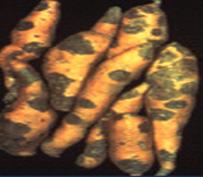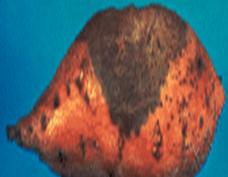| Black Rot: Ceratocystis fimbriata
Symptoms:
-
Small, circular, slightly sunken, dark brown spots are the initial symptoms of black rot.
-
Spots enlarge and appear greenish black to black when wet and grayish black when dry. Within the spots are small, black fungal structures (perithecia) with long necks which appear to the naked eye as dark bristles. The rot usually remains firm and shallow.
-
If secondary fungi or bacteria invade the tissue however, the flesh beneath the spot turns black, and this blackened area may extend to the center of the root.
-
Tissue near the discolored area may have a bitter taste. Eventually, the entire root may rot. Roots may appear healthy at harvest but rot in storage, during transit, or in the market.
Management
-
Control black rot with crop rotation, since most crops are unaffected by the disease.
-
Disinfect seedbeds if a clean site is unavailable.
-
Propagate plants from healthy stem cuttings.
-
Cure roots immediately after harvest. (Cure roots at 85 to 95 degrees F and 85 to 90 percent relative humidity for 5 to 10 days.)
-
Apply a postharvest fungicide.
-
Do not wash and package roots showing symptoms of black rot.
-
Decontaminate equipment that comes into contact with an infected crop.
-
Spray empty washing machines and crates with a fungicide.
-
Fumigate storage structures.
|
 |
External views of roots infected with black rot. |
| |
 |
Symptom at advanced stage |
|


